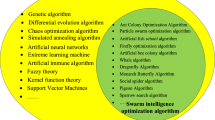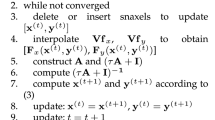Abstract
Hough transform (HT) has been the most common method for circle detection that delivers robustness but adversely demands considerable computational efforts and large memory requirements. As an alternative to HT-based techniques, the problem of shape recognition has also been handled through optimization methods. In particular, extracting multiple circle primitives falls into the category of multi-modal optimization as each circle represents an optimum which must be detected within the feasible solution space. However, since all optimization-based circle detectors focus on finding only a single optimal solution, they need to be applied several times in order to extract all the primitives which results on time-consuming algorithms. This paper presents an algorithm for automatic detection of multiple circular shapes that considers the overall process as a multi-modal optimization problem. In the detection, the approach employs an evolutionary algorithm based on the way in which the animals behave collectively. In such an algorithm, searcher agents emulate a group of animals which interact to each other using simple biological rules. These rules are modeled as evolutionary operators. Such operators are applied to each agent considering that the complete group maintains a memory which stores the optimal solutions seen so-far by applying a competition principle. The detector uses a combination of three non-collinear edge points as parameters to determine circle candidates (possible solutions). A matching function determines if such circle candidates are actually present in the image. Guided by the values of such matching functions, the set of encoded candidate circles are evolved through the evolutionary algorithm so that the best candidate (global optimum) can be fitted into an actual circle within the edge-only image. Subsequently, an analysis of the incorporated memory is executed in order to identify potential local optima which represent other circles. Experimental results over several complex synthetic and natural images have validated the efficiency of the proposed technique regarding accuracy, speed and robustness.














Similar content being viewed by others
References
da Fontoura Costa L, Marcondes Cesar R, Jr (2001) Shape analysis and classification. CRC Press, Boca Raton
Atherton TJ, Kerbyson DJ (1993) Using phase to represent radius in the coherent circle hough transform. In: Proc, IEE colloquium on the hough transform. IEE, London
Shaked D, Yaron O, Kiryati N (1996) Deriving stopping rules for the probabilistic Hough transform by sequential analysis. Comput Vis Image Underst 63:512–526
Xu L, Oja E, Kultanen P (1990) A new curve detection method: randomized Hough transform (RHT). Pattern Recognit Lett 11(5):331–338
Han JH, Koczy LT, Poston T (1993) Fuzzy Hough transform. In: Proc 2nd int conf on fuzzy systems, vol 2, pp 803–808
Becker J, Grousson S, Coltuc D (2002) From Hough transforms to integral geometry. In: Proc int geoscience and remote sensing symp, 2002 IGARSS_02, vol 3, pp 1444–1446
Jiang L (2012) Efficient randomized Hough transform for circle detection using novel probability sampling and feature points. Optik 123(10):1834–1840
Valova I, Milano G, Bowen K, Gueorguieva N (2011) Bridging the fuzzy, neural and evolutionary paradigms for automatic target recognition. Appl Intell 35(2):211–225
An S-Y, Kang J-G, Choi W-S, Oh S-Y (2011) A neural network based retrainable framework for robust object recognition with application to mobile robotics. Appl Intell 35(2):190–210
Ayala-Ramirez V, Garcia-Capulin CH, Perez-Garcia A, Sanchez-Yanez RE (2006) Circle detection on images using genetic algorithms. Pattern Recognit Lett 27:652–657
Cuevas E, Ortega-Sánchez N, Zaldivar D, Pérez-Cisneros M (2012) Circle detection by harmony search optimization. J Intell Robot Syst 66(3):359–376
Cuevas E, Oliva D, Zaldivar D, Pérez-Cisneros M, Sossa H (2012) Circle detection using electro-magnetism optimization. Inf Sci 182(1):40–55
Cuevas E, Zaldivar D, Pérez-Cisneros M, Ramírez-Ortegón M (2011) Circle detection using discrete differential evolution optimization. PAA Pattern Anal Appl 14(1):93–107
Dasgupta S, Das S, Biswas A, Abraham A (2010) Automatic circle detection on digital images with an adaptive bacterial foraging algorithm. Soft Comput 14(11):1151–1164
Li Y, Zeng X (2010) Multi-population co-genetic algorithm with double chain-like agents structure for parallel global numerical optimization. Appl Intell 32(3):292–310
Das S, Maity S, Qub B, Suganthan PN (2011) Real-parameter evolutionary multimodal optimization—a survey of the state-of-the-art. Swarm Evol Comput 1:71–88
Goldberg DE, Richardson J (1987) Genetic algorithms with sharing for multimodal function optimization. In: Proc of the second international conference on genetic algorithms (ICGA), New Jersey
Kennedy J, Eberhart RC (1995) Particle swarm optimization. In: Proceedings of the 1995 IEEE international conference on neural networks, vol 4, pp 1942–1948
Norouzzadeh MS, Ahmadzadeh MR, Palhang M (2012) LADPSO: using fuzzy logic to conduct PSO algorithm. Appl Intell 37(2):290–304
Ben Ali YM (2012) Psychological model of particle swarm optimization based multiple emotions. Appl Intell 36(3):649–663
Liang J, Qin AK, Suganthan PN (2006) Comprehensive learning particle swarm optimizer for global optimization of multi-modal functions. IEEE Trans Evol Comput 10(3):281–295
Chen DB, Zhao CX (2009) Particle swarm optimization with adaptive population size and its application. Appl Soft Comput 9(1):39–48
Xu Q, Lei W, Si J (2010) Predication based immune network for multimodal function optimization. Eng Appl Artif Intell 23:495–504
Sumper D (2006) The principles of collective animal behaviour. Philos Trans R Soc Lond B, Biol Sci 361(1465):5–22
Petit O, Bon R (2010) Decision-making processes: the case of collective movements. Behav Process 84:635–647
Kolpas A, Moehlis J, Frewen T, Kevrekidis I (2008) Coarse analysis of collective motion with different communication mechanisms. Math Biosci 214:49–57
Couzin I (2008) Collective cognition in animal groups. Trends Cogn Sci 13(1):36–43
Couzin ID, Krause J (2003) Self-organization and collective behavior in vertebrates. Adv Study Behav 32:1–75
Bode N, Franks D, Wood A (2010) Making noise: emergent stochasticity in collective motion. J Theor Biol 267:292–299
Couzi I, Krause I, James R, Ruxton G, Franks N (2002) Collective memory and spatial sorting in animal groups. J Theor Biol 218:1–11
Couzin ID (2007) Collective minds. Nature 445:715–728
Bazazi S, Buhl J, Hale JJ, Anstey ML, Sword GA, Simpson SJ, Couzin ID (2008) Collective motion and cannibalism in locust migratory bands. Curr Biol 18:735–739
Hsu Y, Earley R, Wolf L (2006) Modulation of aggressive behaviour by fighting experience: mechanisms and contest outcomes. Biol Rev 81(1):33–74
Ballerini M (2008) Interaction ruling collective animal behavior depends on topological rather than metric distance: evidence from a field study. Proc Natl Acad Sci USA 105:1232–1237
Yang X-S (2008) Nature-inspired metaheuristic algorithms. Luniver Press, Beckington
Gandomi AH, Yang X-S, Alavi AH (2011) Cuckoo search algorithm: a metaheuristic approach to solve structural optimization problems. Eng Comput. doi:10.1007/s00366-011-0241-y
Zang H, Zhang S, Hapeshi K (2010) A review of nature-inspired algorithms. J Bionics Eng 7:S232–S237
Gandomi A, Alavi A (2012) Krill herd: a new bio-inspired optimization algorithm. Commun Nonlinear Sci Numer Simul 17:4831–4845
Bresenham JE (1977) A linear algorithm for incremental digital display of circular arcs. Commun ACM 20:100–106
Van Aken JR (2005) Efficient ellipse-drawing algorithm. IEEE Comput Graph Appl 4(9):24–35
Wilcoxon F (1945) Individual comparisons by ranking methods. Biometrics 1:80–83
Garcia S, Molina D, Lozano M, Herrera F (2008) A study on the use of non-parametric tests for analyzing the evolutionary algorithms’ behaviour: a case study on the CEC’2005 special session on real parameter optimization. J Heuristics. doi:10.1007/s10732-008-9080-4
Santamaría J, Cordón O, Damas S, García-Torres JM, Quirin A (2008) Performance evaluation of memetic approaches in 3D reconstruction of forensic objects. Soft Comput. doi:10.1007/s00500-008-0351-7
Chen T-C, Chung K-L (2001) An efficient randomized algorithm for detecting circles. Comput Vis Image Underst 83:172–191
Author information
Authors and Affiliations
Corresponding author
Rights and permissions
About this article
Cite this article
Cuevas, E., González, M. Multi-circle detection on images inspired by collective animal behavior. Appl Intell 39, 101–120 (2013). https://doi.org/10.1007/s10489-012-0396-2
Published:
Issue Date:
DOI: https://doi.org/10.1007/s10489-012-0396-2




